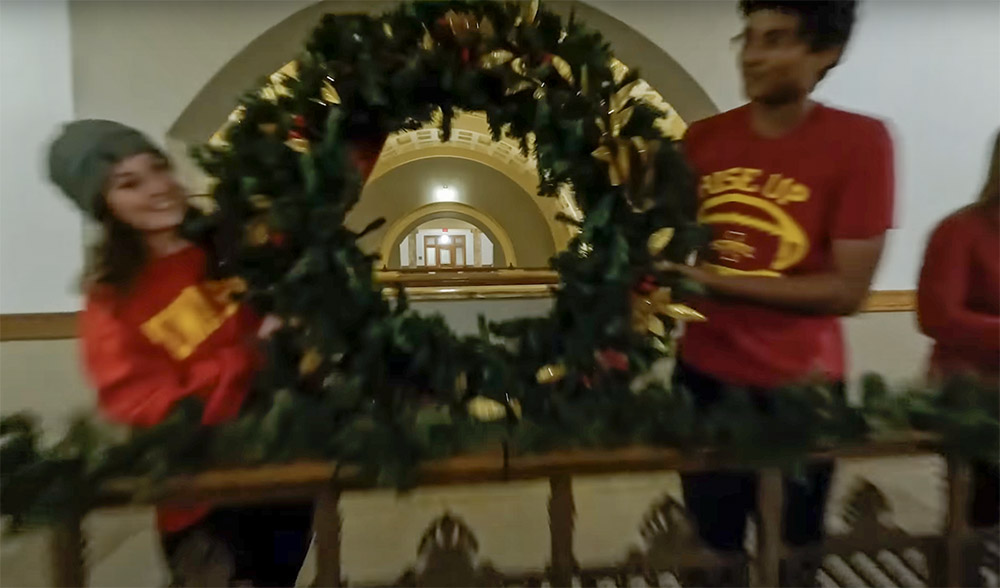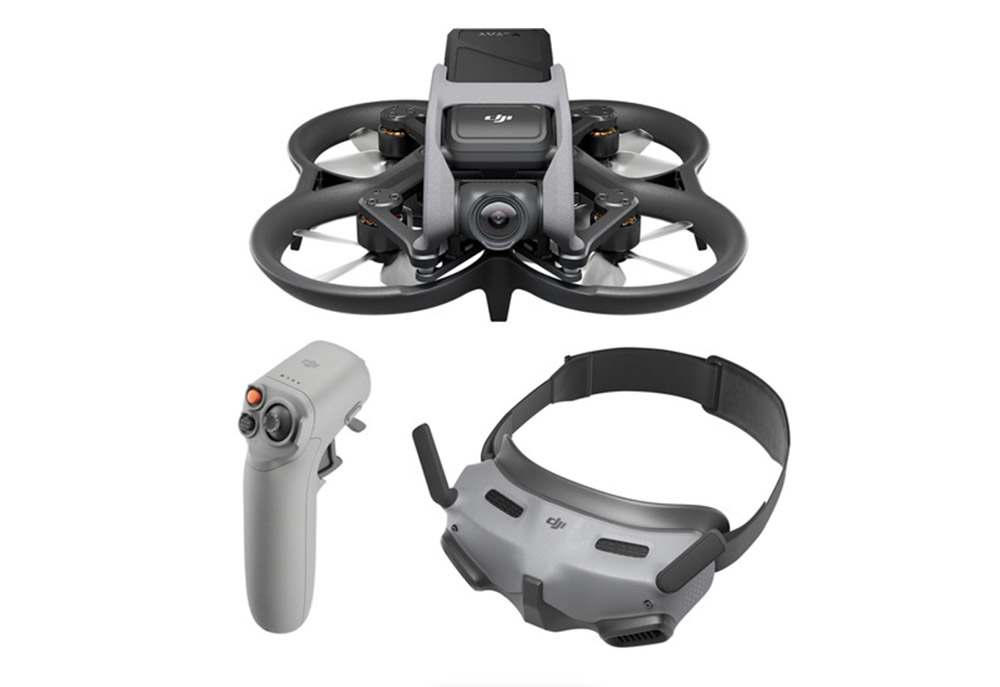
UPAA Blog 2023-24 #7 11/30/23 (text by Ryan Riley, above frame grab of a video by Ian Tunney)
This is the fourth and final article in a series on drones.
The first article compared features and image quality on three reasonably priced DJI drones.
The second article detailed the process of getting approval to fly in a stadium TFR.
The third article showed the opportunities available by just adding a small LED light.
This article shows some of the storytelling uses for FPV drones. "What's FPV drones?" Literally, it stands for "First Person View," meaning the experience of the drone pilot. More broadly it refers to what are typically smaller drones with shielded propellers that can maneuver indoors and in tight spaces. FPV drones can give an immersive and unusual perspective. But are they a tool or a gimmick? Ryan Riley from Iowa State University and a team of colleagues used an FPV drone to make a holiday video which was awarded at the 2023 UPAA Symposium. Ryan and team were responsible for the creative direction and Iowa State hired an outside pilot for that production. Nate Edwards from BYU offers some thoughts on his own experience piloting a FPV drone.-Ed
Above: The 2022 Iowa State holiday video
We have a small team of communications and strategic engagement professionals from across campus (6 people) who work together to conceptualize and execute these holiday videos from our university president.
When the team met in August, I brought several kernels of concepts that could be possibilities for a holiday video.
One of these was to have the Iowa State Singers, a student choir of 70-plus members, singing around the opulent open rotunda in one of our most recognizable historic buildings.
The other kernel was my fascination with FPV drones and their video capabilities since this Venice Beach video caught my attention years ago, and of course, the bowling alley video. I saw FPV as an exciting way to bring viewers into the experience. Another advantage of FPV is that it's still new enough that many people haven't seen it done, especially in a familiar place.
We merged the two concepts into a FPV drone video featuring indoor vignettes that would motivate the camera movement, culminating with the drone spiraling down the rotunda with the choir in full voice, then exiting the building and flying over the annual campus holiday tree. The heart of it was remembering that FPV drones are just tools in the toolbox. We weren't making an FPV video as much as we were making a video using an FPV drone. There are plenty of bad FPV videos out there that maybe show off a location but have no heart; we wanted the audience to take a thrilling journey through the space but still get back to that sentimentality by the end.
Once we settled on this concept and had buy-in from the president, building out the video began:
Story: We wanted to show the president leaving her office and walking down to the main door at the end of the day, providing us with bookends to our "story" structure of vignettes throughout the rest of the building.
Song: For more than 90 years, The Bells of Iowa State has been a beloved song for our campus. It has a romantic and sentimental feel, so we like to use it often during the holiday season. We partnered with the Department of Music and Theatre to engage the student choir, and worked with a faculty member to identify an arrangement of the song that would work with the timing of our story structure. The Iowa State Singers recorded the arrangement in a recital hall for use in the final video.
For the big musical swell toward the end of the piece, we wanted the large choir to suddenly appear gathered around the top levels of the open rotunda. Until then, the FPV drone would make a circuit through the building after showing the president walking out of her office.
Vignettes: We mapped a route through the building that the drone could follow and planned where the student-focused vignettes of holiday decorating could take place and what they would consist of.
Pilot: No one on campus currently flies FPV, so we needed to identify an experienced FPV pilot and get facility clearance to fly in the building. I was impressed by Ian Tunney's work on Instagram and pitched the concept to him. I had several calls with him to discuss the concept, and he was excited to be involved.
The shoot: Ian arrived in town the evening before the shoot. We had a few walkthrough flights in the space with no people involved to ensure the timing was as precise as possible — because we would only have the student singers for 45 minutes, a scheduling challenge we were determined to make work. We ended up capturing about four full takes in that time.
Additional Challenges:
- Playing the singers' prerecorded music track loud enough for them to hear and to lip sync — while a loudly buzzing drone was flying in the big open space. The solution: Big amplifiers borrowed from the music department. It also helped to schedule some quick, droneless walk-throughs with different sets of students prior to filming and prep them for the "swarm of bees" sound that would occur when the drone was in flight.
- Cueing the president and the singers when they should move into their spots. The solution: One large megaphone and a team of hidden cue-providers equipped with walkie-talkies.
- Hiding Ian (the pilot) and myself in a location that was out of the shot but close enough to maintain a strong signal from the remote to the drone. The solution was a spot behind some pillars right next to where the president leaves the building.
- Toward the end of our filming that night, we realized it had gotten too dark outside for the FPV drone to get a usable shot with that small GoPro sensor. I came back the next day and flew our DJI Mavic Air 2 just for the section where the drone leaves the building, flies past the tree, and then turns and looks back at the building. We did our best to hide the cut using the door frame. So, while our original concept was for the entire video to be one take, it ended up being around 90 percent one take.
- It was extremely difficult to watch and assess each take on the monitor as it was unfolding and still manage to cue the singers and president at the right time. On one of the takes, I was so busy watching what was coming through on the monitor that I forgot to cue the singers. It was the most challenging shoot I have been a part of.
- We met with plenty of logistics questions to answer and hurdles to clear that involved campus operations and security staff. Our Office of Risk Management reviewed the plans, emphasizing the proof of insurance (insurance certificate) required from the drone operator. The precision and control demonstrated by the FPV operator throughout multiple dry runs prior to actual filming was helpful to witness.
This couldn't have happened without a very dedicated team working together: Haley Cook, Jed Findlay, Megan Landolt, Brian Meyer, and Max Moore. I did feel an immense amount of pressure before and during the shoot, mostly due to that small window with the singers, but our tight-knit team considered nearly every aspect as a group, and we knew what we were trying to do was possible with the drone and pilot thanks to the walkthroughs, so it was just a matter of following through on the months of planning.
SIDEBAR: What's it like to pilot a FPV Drone?

text and video by Nate Edwards (above photo: A DJI Avata FPV drone from the B&H website)
I wanted to dip my toe in the FPV pool a little bit and thought it a good opportunity when the DJI Avata came out. Flying an FPV drone is for sure much different than flying a regular drone, especially when learning how to fly it. There are similarities but there are also many differences. If you are wanting to learn to fly an FPV, I would strongly recommend downloading a simulator first and spend hours trying to master flying before actually flying the drone in real life. Once you try the simulator for the first time, you will understand why. It’s much cheaper to crash a hundred times in virtual reality than it is in actual reality.
One of the benefits of the Avata is the option of flying with the Motion Controller, which is like a joystick you hold in your hand. You basically pull a trigger for your throttle and move your wrist left and right, and up and down to tell the drone where to go. It is much easier to fly with and still a lot of fun, however, it does limit you in your maneuverability. You won’t be able to get the crazy shots you are used to seeing on YouTube (that would take a LOT of hours of practice to be able to fly like that anyways). The learning curve for the motion controller is much less and it is pretty intuitive.
After I was finally able to fly our main drone during football games this season, my next quest was to dive more deeply into flying an FPV at football games. I know we have all seen the amazing runout shots with the team in a full stadium and there was a legal way to do that, and I was excited to jump into that world until the NCAA came out with a new rule that essentially said you can’t fly over the field when any athlete is present on the field, etc. So, no more flying over people legally if they are an athlete.
All that being said, we still haven’t found the best use for an FPV and will be exploring it further. The problem with the Avata and other “larger” FPV drones is they fall out of the weight class to be able to fly over people legally, so you are limited in what you can do.
Here is an example of one of the times we used it to show the length of the line of our student section waiting to get into a basketball game.
Since we couldn’t legally fly over the students, I just flew it off to the side, and it was still effective, but not as good as it could have been. This was like my 3rd time flying the drone and it is harder to keep it steady with the motion controller as you can see in the footage but it was still great content for social media.
"What do sweet potatoes wear to bed? Yammies!" Hey it's still close enough to Thanksgiving...got a better joke? Send it our way! Email editor Matt Cashore, mcashore@nd.edu. And, as always, follow UPAA on Instagram.